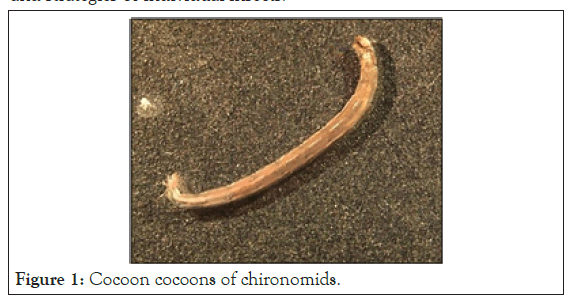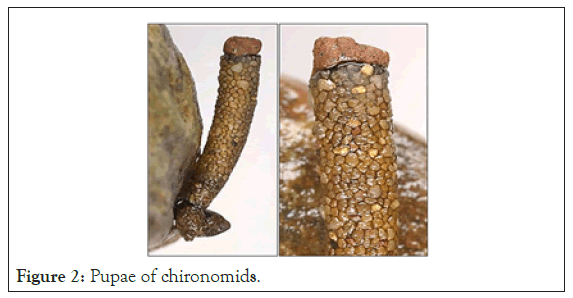Journal of Oceanography and Marine Research
Open Access
ISSN: 2572-3103
+44 1300 500008
ISSN: 2572-3103
+44 1300 500008
Short Communication - (2021)Volume 9, Issue 8
Many insects live in regions that are cold enough for their habitats to be ice–covered or frozen during winter. Where do aquatic insects go for the winter? What do they do there? How do they cope with the low temperatures?. Small bodies of water are not well buffered against winter cold however overlying snow provides insulation from cold air temperatures and the ice many not get very thick even on small ponds. In large lentic habitats the sediments also remain unfrozen. In lotic waters, flow restricts ice formation, although rivers can freeze in to the substrate if flow is low during cold winters. Winter conditions in aquatic habitats, therefore, depend on how the size, geometry and flow of each habitat. Over winter in cocoons or shelters, for example, the distinctive winter cocoons of chironomids enhance survival during experimental freezing (Figure 1) [1]. Cases are attached to the substrate or sealed (Figure 2) [2]. Water loss is the key to a different method of cold hardiness, dehydration to ice outside the body that keeps the concentration of body solutes high enough that freezing cannot occur. Adaptations for cold hardiness, including an increase of cryoprotectants, habitat selection, and adjustments of water content. Some of the common cryoprotectants are glycerol, dimethyl sulfoxide (DMSO) [3-6], ethyl glycol, and propylene glycol. Some insect larvae, including mayflies and chironomids, can withstand anoxia for a long time. Some species tolerate the high flows. Others move away from the main channel to tributaries as break upstarts. Some steam species overwinter in headwater lakes or spring habitats and thus escape disturbances in the outlet channels. Mechanical protection against ice could be: Overwintering in deep layers, burrowing even to a shallow depth, build cases or shelters. Every year billions of butterflies, dragonflies, moths and other insects migrate across continents, and considerable progress has been made in understanding population-level migratory phenomena. However, little is known about destinations and strategies of individual insects.

Figure 1: Cocoon cocoons of chironomids.

Figure 2: Pupae of chironomids.
Numerous species of insects engage in long-distance migrations that may require multiple generations. Environmental conditions largely regulate the initiation and displacement of insect migrations. Populations of migratory insects may delay emigration flights if the wind speed is excessive. Further, precipitation or cool air temperature may inhibit emigration flights. Vertical stratification of air temperature, wind speed, or wind direction can lead to concentration of migrating insects into relatively thin altitudinal layers. In southern India, mass migrations of many species occur before monsoons. As many as 250 species of butterflies in India are migratory. These include members of the Pieridae and Nymphalidae. The Australian painted lady periodically migrates down the cost of Australia and occasionally, in periods of strong migration in Australia, migrate to New Zealand. The monarch butterfly migrates from southern Canada to wintering sites in central Mexico where they spend the winter. In the late winter or early spring, the adult monarchs leave the Transvolcanic mountain range in Mexico to travel north. Mating occurs and the females seek out milkweed to lay their eggs, usually first in northern Mexico and southern Texas. The caterpillars hatch and develop into adults that move north, where more offspring can go as far as Central Canada until the next migratory cycle. The entire annual migration cycle involves five generations. Some of insect migrate during the cold season and travel to the hot environment such as Monarch butterfly [7] which migrate from Canada to southern parts of the word during winter and return in the summer [8].
Fall armyworm, Spodoptera frugiperda (Smith), is a highly mobile insect pest of a wide range of host crops. However, this pest of tropical origin cannot survive extended periods of freezing temperature but must migrate northward each spring if it is to re-infest cropping areas in temperate regions. It has a high reproductive rate of 900–1000 eggs per female, a relatively short generation time of 30 days and good dispersal
ability. These traits make it a successful colonizing species. There is a large body of circumstantial evidence that migration is a major component in the life history strategy of this species. Migratory flight allows many insect species to rapidly expand their access to resources, which is critically important when local resources are inadequate or depleted [9].
Locust migration is one of important cause of damages to plant cultures in the world. Short-horned grasshoppers sometimes form swarms that will make long flights. These are often irregular and may be related to resource availability and thus not fulfilling some definitions of insect migration. There are however some populations of species such as locusts (Schistocerca gregaria) that make regular seasonal movements in parts of Africa exceptionally, the species migrates very long distances, as in 1988 when swarms flew across the Atlantic Ocean. Coccinellidae migration also happens in the environment [10].
Diving beetles are the most diverse beetles in the aquatic environment and can be found in almost every kind of freshwater habitat, from small rock pools to big lakes. Some dytiscid species are also found in brackish water. Diving beetles live in water bodies in various landscapes, including agricultural and urban landscapes some of aquatic coleopteran such as Dytiscidae family, water beetle migration occurs during the cold seasons [11]. Dragonflies are among the longest distance insect migrants. Many species of Libellula, Sympetrum and Pantala are known for their mass migration. Pantala flavescens is thought to make the longest ocean crossings among insects, flying between India and Africa on their migrations. Their movements are often assisted by winds. [12].
This research is financially supported by Ministry of Health and Medical Education under code number of NIMAD 995633.
Citation: Vatandoost H (2021) Adaptation of Arthropods to Winter Cold and Freezing Conditions. J Oceangr Mar Res. 9: 232.
Received: 06-Aug-2021 Accepted: 20-Aug-2021 Published: 27-Aug-2021 , DOI: 10.35248/2572-3103.21.9.232
Copyright: © 2021 Vatandoost H. This is an open-access article distributed under the terms of the Creative Commons Attribution License, which permits unrestricted use, distribution, and reproduction in any medium, provided the original author and source are credited.